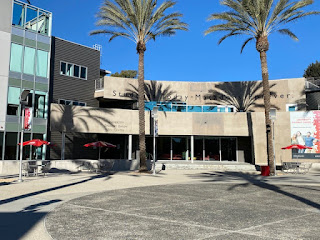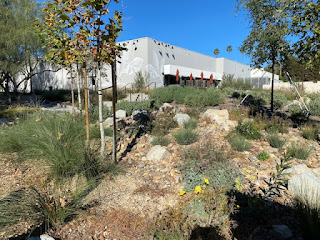Week 256: California State University—Northridge
January 09, 2022CSUN Lower Campus, 2.9 miles.
I've been attending CSUN as a part-time History student for three semesters now, and thanks to Covid I've never set foot on campus. That all changes when I attend my first class in person in February, so Barbara and I thought it might be a good idea to hike the campus so I'll know where the hell to go! We hiked the lower campus (upper is all athletic fields and student housing), and selected a route that combined buildings-I-need-to-know with some of CSUN's historic markers. The third largest university in LA based on enrollment, CSUN started as a satellite campus for Los Angeles State College in 1952. In 1958, it separated from LA State College and opened as San Fernando Valley State College on 356 acres in the middle of a rural, agricultural section of Northridge with trailers and borrowed faculty. Enrollment: 2500. Tuition: $25/semester. The official name change to CSUN came in 1972, and today it claims the third biggest enrollment in LA behind USC and UCLA. The campus is beautiful, with so many nods to its agricultural and nature-based history. Barbara and I started our hike from the most important place for me: Parking Lot B3, a short walk to Sierra Hall, home to History Department classrooms and offices and one of the oldest and biggest buildings on campus. From Sierra we walked North to check out the fountain on Cleary Walk named for Ralph Prator, the inaugural president of CSUN (1958–1968). Next stop, the huge, million+ book University Library, then we swung down to see the building housing CalState system's only full astronomy department with its own planetarium. Cool. Next stop, a photo at the Matador statue sculpted in bronze by Jon Hair in 2011. Heading up Lindley Ave, we passed the Wellness Garden, small plot for hands-on classes on growing healthy food. We made our turnaround at University Drive and backtracked past Redwood Hall for a window-peek at the Kinesiology Dept's remarkable sculpture. A turn at Jacaranda Walk took us to the stunning Student Recreation Center housing a full gym, indoor courts upstairs, and a rock-climbing wall in the lobby. The SRC is across from the Student Union (including coffee house: Freudian Sip) and the Wellness Center's outdoor pool. Crossing back to Lindley Ave., we walked south past the Botanic Garden—one of the 50 Most Amazing University Botanic Gardens in the US. Pandemic restrictions kept us out, so we headed for the Orange Grove bordering Nordhoff Street. The orange grove, lush with fat oranges and squirrels, is one of the few remaining historic (circa 1920s) groves still thriving in the Valley. A quick side trip to the CSUN logo sculpture at the corner of Nordhoff and Zelzah for a pic before we crossed through the orange grove to the Duck Pond alive with quackers and turtles, then across to the Stellar and Solar Observatories. Our final stop was the Earthquake Garden on the Mike Curb College Arts Walk. When the Northridge Earthquake hit LA on January 17, 1994, the epicenter was located only two miles from CSUN. The school suffered an estimated $400 million in severe damage, yet the dedicated faculty and staff managed to reopen the university 4 weeks later. The Earthquake Garden has benches and tables made from concrete remnants of the destruction in a serene nature setting, a stirring reminder that we're not the boss of this planet. The campus has a "new" feel to it, with beautiful architecture and constant reminders of the natural beauty of California flora. The hike was so much fun for me—it gave practical and historic context to what's already been one of my best life journeys, and I can't wait to attend my first class at Sierra Hall! Thank God I know where to park.




























0 comments